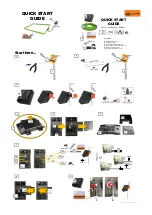
1
SLVUAY7B – November 2016 – Revised January 2018
Copyright © 2016–2018, Texas Instruments Incorporated
TPS22810 Load Switch Evaluation Module
User's Guide
SLVUAY7B – November 2016 – Revised January 2018
TPS22810 Load Switch Evaluation Module
The TPS22810EVM evaluation module (EVM) allows the user to connect power to and control the 6-pin
TPS22810 load switch device. Parameters such as the on-resistance, rise time, and quick output
discharge can easily and accurately be evaluated.
lists a short description of the TPS22810 load
switch performance specifications.
Table 1. TPS22810 Rise Time, Output Current Rating, Enable, Undervoltage Lockout, and Output
Discharge Characteristics
EVM
Device
Rise Time Typical
(
μ
s)
V
IN
(V)
Maximum Continuous
Current (A)
Enable
(EN/UVLO)
Quick Output
Discharge
TPS22810EVM
TPS22810DBV (CH1)
Adjustable
2.7 to 18
2
Active High
Adjustable
TPS22810EVM
TPS22810DRV (CH2)
Adjustable
2.7 to 18
3
Active High
Adjustable
NOTE:
The TPS22810-Q1 can also be evaluated on this EVM by replacing the TPS22810DBV (U1)
with the TPS22810TDBVRQ1.
Trademarks
All trademarks are the property of their respective owners.
1
Introduction
1.1
Description
The TPS22810EVM is a two-layer PCB containing the TPS22810 load switch device. The TPS22810EVM
supports two packages for TPS22810 device, SOT-23 package (DBV) on CH1 and SON package (DRV)
on CH2. The VIN and VOUT connections to the device and the PCB layout routing are capable of
handling high continuous currents and provide a low-resistance pathway into and out of the device under
test. Test point connections allow the EVM user to control the device with user-defined test conditions and
make accurate RON measurements.
1.2
Features
This EVM has the following features:
•
V
IN
input voltage range: 2.7 to 18 V
•
Access to the VIN, VOUT, CT, QOD, GND, and EN pins of the TPS22810 load switch device
•
Onboard CIN, COUT, and CT capacitors
•
2-A maximum continuous current operation for TPS22810DBV
•
3-A maximum continuous current operation for TPS22810DRV
•
Ability to adjust the QOD resistance using jumpers
•
Ability to change COUT capacitor using jumpers


































